
USS President was a wooden-hulled, three-masted heavy frigate of the United States Navy, nominally rated at 44 guns; she was launched in April 1800 from a shipyard in New York City. President was one of the original six frigates whose construction the Naval Act of 1794 had authorized, and she was the last to be completed. The name "President" was among ten names submitted to President George Washington by Secretary of War Timothy Pickering in March of 1795 for the frigates that were to be constructed. Joshua Humphreys designed these frigates to be the young Navy's capital ships, and so President and her sisters were larger and more heavily armed and built than standard frigates of the period. Forman Cheeseman, and later Christian Bergh were in charge of her construction. Her first duties with the newly formed United States Navy were to provide protection for American merchant shipping during the Quasi War with France and to engage in a punitive expedition against the Barbary pirates in the First Barbary War.

HMS Endymion was a 40-gun fifth rate that served in the French Revolutionary Wars, the Napoleonic Wars, the War of 1812 and during the First Opium War. She was built to the lines of the French prize Pomone captured in 1794. Due to her exceptional handling and sailing properties, the Severn-class frigates were built to her lines, although the gunports were rearranged to mount an extra pair of guns per side, the ships were made of softwood and were not built until nearly the end of the Napoleonic Wars.
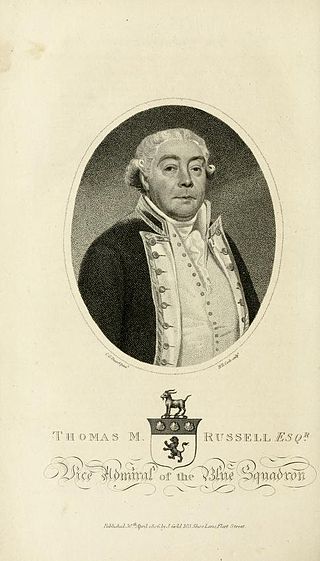
Thomas McNamara Russell was an admiral in the Royal Navy. Russell's naval career spanned the American Revolutionary War, French Revolutionary War and Napoleonic War.

Jean-Baptiste Philibert Willaumez was a French naval officer and nobleman who served during the French Revolutionary Wars and Napoleonic Wars. Willaumez joined the French Navy at the age of 14, and proved to be a competent sailor. Having risen to the rank of pilot, he started studying navigation, attracting the attention of his superiors up to Louis XVI himself. Willaumez eventually became an officer and served under Antoine Bruni d'Entrecasteaux in his expedition to rescue Jean-François de Galaup, comte de Lapérouse and explore the Indian Ocean and Oceania.

The action of 29 November 1811 was a minor naval engagement fought between two frigate squadrons in the Adriatic Sea during the Adriatic campaign of the Napoleonic Wars. The action was one of a series of operations conducted by the British Royal Navy and the French Navy to contest dominance over the Adriatic between 1807 and 1814. During this period the Adriatic was surrounded by French territory or French client states and as a result British interference was highly disruptive to the movement of French troops and supplies.

Sibylle was a 38-gun Hébé-class frigate of the French Navy. She was launched in 1791 at the dockyards in Toulon and placed in service in 1792. After the 50-gun fourth rate HMS Romney captured her in 1794, the British took her into service as HMS Sybille. She served in the Royal Navy until disposed of in 1833. While in British service, Sybille participated in three notable single-ship actions, in each case capturing a French vessel. On anti-slavery duties off West Africa from July 1827 to June 1830, Sybille captured many slavers and freed some 3,500 slaves. She was finally sold in 1833 in Portsmouth.

Magicienne was a frigate of the French Navy, lead ship of her class. The British captured her in 1781 and she served with the Royal Navy until her crew burned her in 1810 to prevent her capture after she grounded at Isle de France. During her service with the Royal Navy she captured several privateers and participated in the Battle of San Domingo.

HMS Lowestoffe was a 32-gun fifth-rate frigate of the Royal Navy. Built during the latter part of the Seven Years' War, she went on to see action in the American War of Independence and the French Revolutionary War, and served often in the Caribbean. A young Horatio Nelson served aboard her shortly after passing his lieutenant's examination.
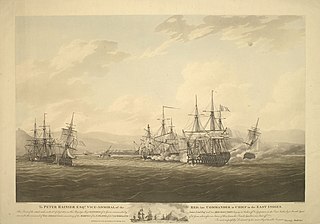
HMS Centurion was a 50-gun Salisbury-class fourth rate of the Royal Navy. She served during the American War of Independence, and during the French Revolutionary and Napoleonic Wars.
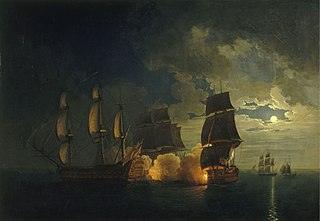
The action of 18 October 1782 was a minor naval engagement of the American Revolutionary War, in which the French 74-gun ship of the line Scipion, accompanied by the 40-gun frigate Sibylle, was chased by two Royal Navy ships of the line, the 98-gun HMS London and the 74-gun Torbay. Outmanoeuvring her larger opponents, Scipion obtained a favourable position that allowed her to rake London, causing severe damage and allowing her to continue running from the superior British force. Scipion went to anchor in Samaná Bay but while doing so hit a rock and sank, while Sibylle succeeded in escaping the area.
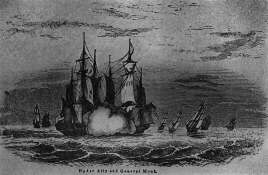
The Battle of Delaware Bay, or the Battle of Cape May, was a naval engagement fought between the Kingdom of Great Britain and the United States during the American Revolutionary War. A British squadron of three vessels attacked three American privateers that were escorting a fleet of merchantmen. The ensuing combat in Delaware Bay near Cape May ended with an American victory over a superior British force.
The action of 22 January 1783 was a single-ship action fought off the Chesapeake Bay during the American War of Independence. The British frigate Hussar, under the command of Thomas McNamara Russell, captured the French frigate Sybille, under the command of Kergariou-Locmaria. The circumstances of the battle included controversial violations of accepted rules of war regarding the flying of false flags and distress signals.

The Battle of Jobourg was a minor naval engagement between British and French frigate squadrons during the last weeks of the War of the Sixth Coalition in the 22nd and penultimate year of the French Revolutionary and Napoleonic Wars. In October 1813 the French Navy, unable to challenge the Royal Navy's dominance at sea, sent two small squadrons of frigates to harass British trade in the Atlantic Ocean. One was brought to battle in January 1814 and defeated near the Canary Islands but the second, from Nantes and consisting of the frigates Etoile and Sultane, fought an inconclusive engagement against British frigate HMS Severn on 4 January in the mid-Atlantic and a furious battle against HMS Astrea and HMS Creole on 23 January near Maio in the Cape Verde Islands.

The action of 28 June 1803 marked the opening shots of the Blockade of Saint-Domingue after the collapse of the Treaty of Amiens and the outbreak of the War of the Third Coalition in May 1803.
Théobald-René, Comte de Kergariou-Locmaria was a French Navy officer and Royalist émigré.
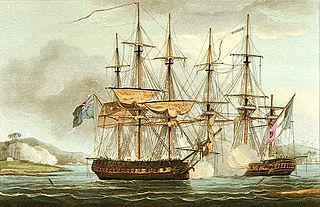
The Battle of Mahé was a minor naval engagement of the last year of the French Revolutionary Wars, fought on 19 August 1801 in the harbour of Mahé in the Seychelles, a French colony in the Indian Ocean. Since the demise of the French Indian Ocean squadron in 1799, the Royal Navy had maintained dominance in the East Indies, controlling the shipping routes along which trade flowed and allowing the rapid movement of military forces around the theatre. French First Consul Napoleon Bonaparte had long-harboured ambitions of threatening British India, and in 1798 had launched an invasion of Egypt as an initial step to achieving this goal. The campaign had failed, and the French army in Egypt was under severe pressure by early 1801, partly due to the presence of a British squadron acting with impunity in the Red Sea.

The Battle of Mykonos was a minor naval engagement fought in the main harbour of the Cycladic island of Mykonos on 17 June 1794 during the French Revolutionary Wars. A British Royal Navy squadron led by fourth rate ship HMS Romney was escorting a convoy of eight merchant ships westwards through the Aegean Sea to Smyrna when the French frigate Sibylle was sighted at anchor in the harbour of Mykonos town with three French merchant ships. Ordering the convoy to continue with the rest of the squadron, Captain William Paget diverted the 50-gun Romney to the port and demanded the surrender of the 40-gun French ship and its convoy.

The action of 28 February 1799 was a minor naval engagement of the French Revolutionary Wars, fought off the mouth of the Hooghly River in the Bay of Bengal between the French frigate Forte and the Royal Navy frigate HMS Sybille. Forte was an exceptionally large and powerful ship engaged on a commerce raiding operation against British merchant shipping off the port of Calcutta in British India. To eliminate this threat, Sybille was sent from Madras in pursuit. Acting on information from released prisoners, Edward Cooke, captain of Sybille, was sailing off Balasore when distant gunfire alerted him to the presence of Forte on the evening of 28 February. The French frigate was discovered at anchor in the sandbanks at the mouth of the Hooghly with two recently captured British merchant ships.
Sibylle was a 32-gun copper-hulled, frigate of the French Navy, lead ship of her class.

HMS Endymion was a 44-gun fifth-rate Roebuck-class ship of the Royal Navy launched in 1779. Based on the design of HMS Roebuck, the class was built for use off the coast of North America during the American Revolutionary War. Commissioned by Captain Philip Carteret, Endymion spent the war serving in the English Channel and West Indies. There, she was damaged in the Great Hurricane of 1780. Sent to England for repairs, Endymion returned to the West Indies in 1782, repeating signals at the Battle of the Saintes. She was present but not engaged at the action of 2 January 1783, before being paid off towards the end of the year.



















